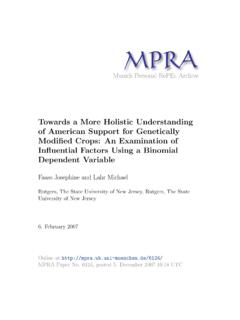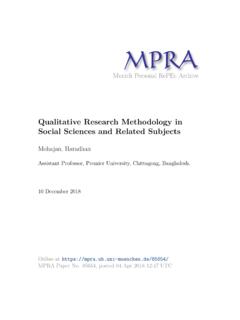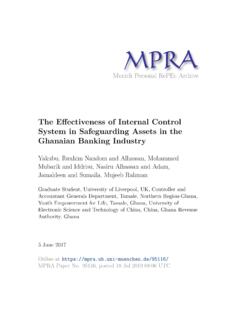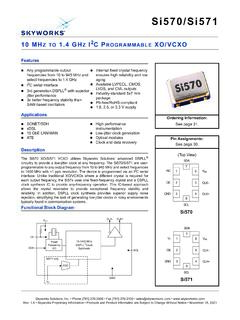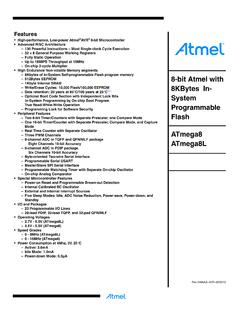Transcription of Design method for two-Stage CMOS operational amplifier ...
1 Munich Personal RePEc ArchiveDesign method for two-Stage cmos operational amplifier applyingload/miller capacitor compensationSadeqi, Abolfazl and Rahmani, Javad and Habibifar, Saeedand Ammar Khan, Muhammad and Mudassir Munir, HafizDepartment of Electronic Engineering, Hadaf University, Sari, Iran,Department of Digital Electronics Engineering, Islamic AzadUniversity, Science Research Branch, Tehran, Iran, Department ofElectrical Engineering, Islamic Azad University Central TehranBranch, Tehran, Iran, University of Electronic Science andTechnology of China, China, Electrical Engineering Department,Sukkur IBA University, Pakistan12 June 2020 Online Paper No. 102931, posted 15 Sep 2020 17:34 UTCR esearch Article Design method for two-Stage cmos operational Amplifier Applying Load/Miller Capacitor Compensation Abolfazl Sadeqi1, Javad Rahmani2 , Saeed Habibifar3, Muhammad Ammar Khan4,5, Hafiz Mudassir Munir6 1 Department of Electronic Engineering, Hadaf University, Sari, Iran 2 Department of Digital Electronics Engineering, Islamic Azad University, Science & Research Branch, Tehran, Iran 3 Department of Electrical Engineering, Islamic Azad University Central Tehran Branch, Tehran, Iran 4 Department of Physical and Numerical Science, Qurtuba University of Science & Information Technology, , Pakistan 5 University of Electronic Science and Technology of China, China 6 Electrical Engineering Department, Sukkur IBA University, Pakistan Keywords Abstract cmos Analog Integrated Circuit, Compensation Circuit, Miller Capacitor, operational Amplifier, Nulling Resistor.
2 cmos operational amplifiers (Op-amp) are present integral components in various analog circuit systems. Adding frequency compensation elements is the only critical solution for avoiding Op-amp instability. This article presents a designed two-Stage cmos Op-amp using a miller capacitor, a nulling resistor, and a common-gate current buffer for compensation purposes. All the Design parameters of the proposed Op-amp were determined based on the corresponding equations of gain, slew rate, phase margin, power dissipation, etc. In order to verify the parameter values, the developed Op-amp circuit was simulated in HSPICE, possessing two critical characteristics: Op-amp with miller capacitor and a robust bias circuit. Afterwards, the expected values from the theoretical section were compared with simulation results thus proving that the advanced method in this paper was validly designed and implemented.
3 This technique promises a real-world scale Op-amp with high unity-gain, excessive input common-mode range voltage, reasonable gain bandwidth, and a practicable slew rate. 1. Introduction Lecture Review operational amplifiers (Op-Amps) are principal element in an analog system. System stability is fundamental in various research areas such as voltage stability employing voltage regulators and capacitors [1, 2]. A two-Stage Op-a mp utilizes miller compensation for stability, engendering a right half-plane (RHP) zero in the open-loop gain from a forward pass through the compensation capacitor, which, in turn, reduces the maximum gain-bandwidth (GBW). Several methods are applied to resolve the forward pass, including Nulling Resistor, Voltage Buffer, Current Buffer, and Current/Voltage Buffer. As the most popular and straightforward, the Nulling Resistor technique enables t he Corresponding Author: Javad Rahmani E-mail address: Received: 12 January 2020; Revised: 12 March 2020; Accepted: 12 June 2020 Please cite this article as: A.
4 Sadeqi, J. Rahmani, S. Habibifar, Design method for two-Stage cmos operational Amplifier Applying Load/Miller Capacitor Compensation, Computational Research Progress in Applied Science & Engineering, CRPASE: Transactions of Electrical, Electronic and Computer Engineering 6 (2020) 153 162. implementation of MOS transistors, creating a left half-plane (LHP) zero with increased gain-bandwidth. Inversely, Voltage Buffer proves higher gain-bandwidth, while Current Buffer technique, a common-gate, boasts remarkable efficiency of the gain-bandwidth and Power Supply Rejection Ratio (PSRR) performance [3]. Moreover, the Current Buffer method can be enhanced if the cascode differential stage is designed in place of a simple differential stage. The maximum gain-bandwidth is limited by the 2nd pole, which depends on the load capacitor. The current buffer can be divided into four segments: 1- Separate and additional common-gate stages (with an LHP Zero and without RHP zero) [4].
5 2- Embedded in cascode first-stage loads (with an LHP Zero and without RHP zero) [5]. 3- Embedded in CASCODED differential pairs (with an LHP Zero and an RHP zero) [6]. 4- Current mirrors stages (with an LHP Zero and without RHP zero) [7]. The combination of all above methods with the addition of miller compensation is applied to compensate for the right half-plane zero. Furthermore, the Voltage Buffer system is significantly accurate, showcasing a simple common-drain, generating a left half-plane zero by higher gain-bandwidth. Although, GBW is equal in both the Nulling Resistors and Voltage Buffer approaches, the latter reduces the output swing [8-10]. In order to Design the Op-amps that operate the negative-feedback connection, the frequency compensation is essential for close-loop stability [11, 12]. Frequency compensation produces a risk for other performance parameters; therefore, well-implemented Op-a mp is required for a compensation strategy.
6 However, attaching a miller capacitance series to the Nulling Resistor is one method of creating an RHP zero. Moreover, the minimal value of Miller capacitance is imperative in reducing noise and improving output power. Consequently, optimization of the noise and output power systems play major roles in the Op-amp Design [13-16]. two-Stage cmos is the most common configuration utilized when designing Op-a mps [ 17]. The 1st stage is defined by a differential input and single-ended output, and the 2nd stage is considered as an inverted output stage. The gain of both stages is achieved between 40dB to 100dB. The addition of an RC network to the system results in frequency compensation, while removing the feed forward path from the 1st stage to the Op-amp, allows Op-a mp to degrade the stability [18, 19]. During the designing stages, a well-known fault diagnosis method was utilized to check the designed Op-amps status [20, 21].
7 Output results of previous studies illustrated that the load capacitance increased up to 100PF can improve the frequency of PSRR [22]. Designing a cmos Op-amp with high unity-gain bandwidth, DC gain, and output swing requires a two-Stage amplifier. The problem with this configuration is reduced speed due to the extra poles and zeros. The result is found in cascode frequency compensation. This system displays greater speed and PSRR than miller compensation, adding a capacitor between the low impedance node of the 1st stage and output node of the 2nd stage. A potential advantage of this system is that the energy production takes place near the consumer, which can minimize the power losses in the distribution lines [23]. Hybrid cascode, a complicated method of cascode compensation, has higher amplifier bandwidth than the standard cascode approach and miller methodologies [24, 25].
8 two-Stage Op-amps are selected in this study because of their improved DC gain and ample output swing. Another method to improve frequency compensation is adding a miller capacitor to the Op-amps and using the objective function to obtain the threshold for the sale of reactive energy [26]. The issue of feedforward signal path that creates (RHP) zero in the Op-amp is addressed by designing a series resistor or voltage/current buffer with a miller capacitor [10]. Contributions While it is important to consider all variables in a perfect Design , this project focused on the optimization of the main simulated parameters as follows: - Gain (AV) - Unity-gain frequency - Power dissipation - Input Common-Mode Range: VCMR - Output swing: Vout(max,min) - Slew Rate: SR - Phase margin: M More specifically, the acquired methodological technique was carried out in three goals: First goal: Design and calculate the element values (W/L, Cc, and Rb) of the circuit depicted in Figure 1 and Figure 2 [27].
9 Second goal: Analyze the circuit and calculate the parameters, namely DC gain (A0), Power Supply Rejection Ratio (PSRR), Common-Mode Rejection Ratio (CMRR). Final goal: Compare simulated and manual results. Figure 1. two-Stage operational amplifier with miller capacitor and common-gate current buffer. Figure 2. operational amplifier with bias current circuit. 2. System Design and Modeling operational Amplifier Compensation Typical two-Stage Op-amp (Figure 1) can be illustrated as the following diagram [28]: Figure 3. Typical two-Stage Op-amp According to Figure 4, the 1st stage is a differential amplifier, and the gain and pole frequency of this stage can be calculated by Eq. (1). Figure 4. COMS differential input stage ()()11211241, mdsdsoutdsdsAgrrCrr == (1) The dominant pole (Cout) of this stage is defined for Derain-Bulk (CDB) capacitances of M4 and M2 transistors.
10 The other pol and zero created by M3 and M1 can be disregarded. According to Figure 5, the 2nd stage is a common-source ( ), and applying the composition of the cascade has capability to increase the gain, specifically after having compensation by miller in this stage. Although high gain leads to lower bandwidth, this article proposed the trad-off between gain and bandwidth. The gain and pole frequency of this stage is obtained by Eq. (2). The dominant pole is related to the Drain-Bulk capacitor (CDB) of M6 and M7 transistors [29]. Figure 5. Common-source amplifier stage. ()()26762561, mdsdsoutdsdsAgrrCrr == (2) Single-stage amplifiers usually have an acceptable frequency response with a phase margin of 90 , supposing that GBW (gain-bandwidth) is 10 times more than pole value. According to the low DC gain of single-stage operational amplifiers, they require at least two or more stages to have a multipolar system.

